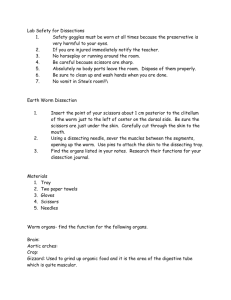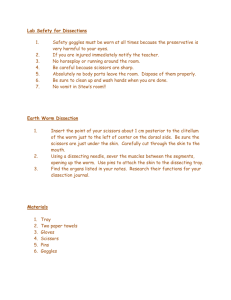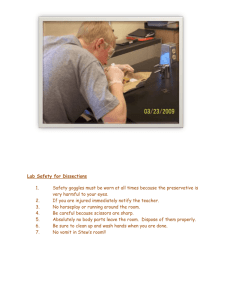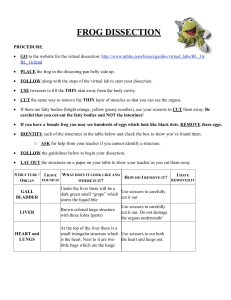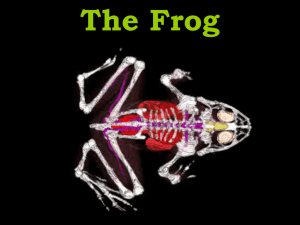Lab Safety for Dissections
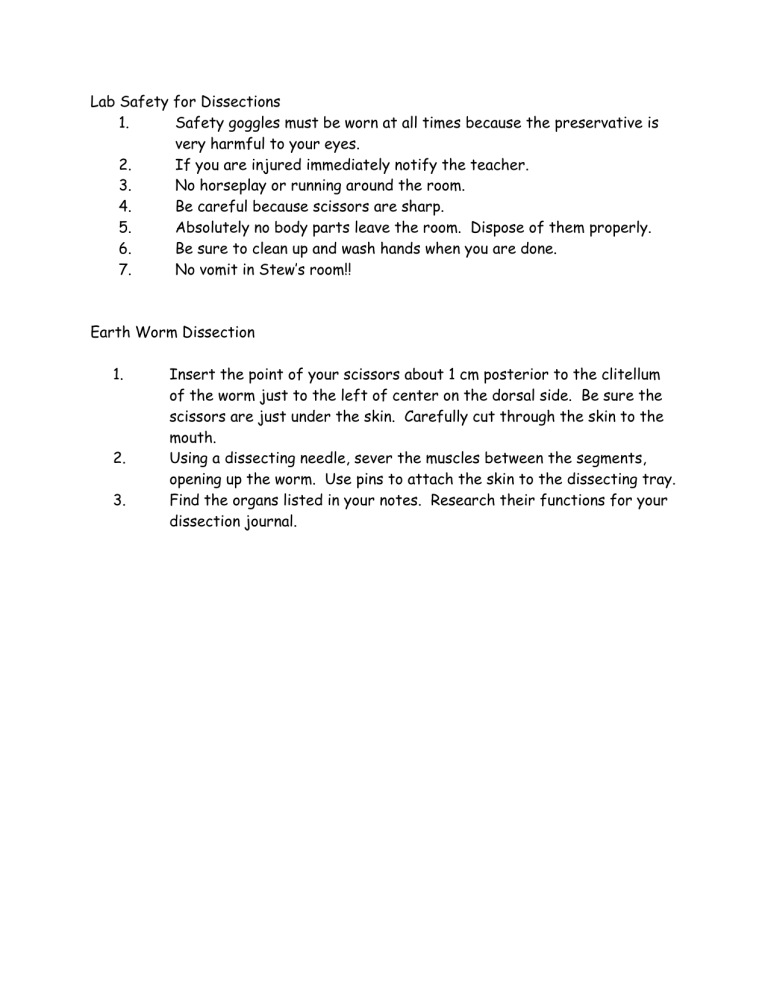
Lab Safety for Dissections
1.
Safety goggles must be worn at all times because the preservative is
2.
3.
4.
5.
6.
very harmful to your eyes.
If you are injured immediately notify the teacher.
No horseplay or running around the room.
Be careful because scissors are sharp.
Absolutely no body parts leave the room. Dispose of them properly.
Be sure to clean up and wash hands when you are done.
7.
No vomit in Stew’s room!!
Earth Worm Dissection
1.
Insert the point of your scissors about 1 cm posterior to the clitellum of the worm just to the left of center on the dorsal side. Be sure the
2.
scissors are just under the skin. Carefully cut through the skin to the mouth.
Using a dissecting needle, sever the muscles between the segments, opening up the worm. Use pins to attach the skin to the dissecting tray.
3.
Find the organs listed in your notes. Research their functions for your dissection journal.
Materials
1.
Tray
2.
Two paper towels
3.
Gloves
4.
Scissors
5.
Needles
Worm organs- find the function for the following organs.
Brain: controls the body
Aortic arches:
Crop:
Gizzard: Used to grind up organic food and it is the area of the digestive tube which is quite muscular.
Intestine:
Dorsal blood vessel: The worm is darker on its upper surface.
Seminal vesicles:
Seminal receptacles: These are only visible when the worm is in reproductive condition.
Esophagus:
Mouth:
Anus:
Clitellum: An organ that is responsible for mucus production during reproduction.
Skin:
Crayfish dissection procedure
1.
Observe the external anatomy of the crayfish. Locate the body parts that are external. Is your crayfish a male or a female? How
2.
do you know this? Locate the mouth of the crayfish. Observe the live crayfish in the tank.
Make a cut in the exoskeleton of the cephalothorax on the dorsal side from the back of the cephalothorax to the rostrum, cutting down the midline. Separate the 2 halves of the exoskeleton to reveal
3.
Materials
1.
Tray the internal organs.
After you find all the internal organs clean up thoroughly.
2.
Two paper towels
3.
Gloves
4.
Scissors
5.
Probe
Fish dissection procedure
1.
Identify all the fins of the fish. Find the lateral line, operculum and gills.
2.
Make a cut from the vent on the ventral side of the fish to an area just below the operculum, cutting between the pelvic fins. Then cut up along the operculum to the lateral line. Cut parallel to the lateral line until you
Fish organs
Operculum: are even with the vent, then cut down to the vent and remove the side of the fish. Locate the internal organs and then clean up thoroughly.
Gills:
Stomach:
Intestine:
Liver:
Heart:
Swim bladder:
Eye:
Ovaries:
Testes:
Caudal fin:
Dorsal fin:
Pectoral fin:
Ventral fin:
Pelvic fin:
Lateral line:
Scales:
Frog dissection questions:
1. How many chambers does a frog heart have? Three chambers
2. How many chambers does a human heart have? Two chambers
3.
Which heart is more efficient, and why does it have to be more efficient?
The frog of a heart because it is three chambers and they have to jump and use their tongue to catch different types of insects.
4. Why does a frog have such small lungs? The frog has such small lungs because they get oxygen absorbed through the skin.
5. How is the tongue of a frog attached in its mouth and why is it attached like this. It is attached to
6. Why is a frog classified as the following? a. ectotherm b. amphibian c. chordate d. animal e. heterotroph
7. Why are amphibian populations declining, and what can we do to save them?
8. Explain how a frog is camouflaged.
9. Is a frog an herbivore, omnivore or carnivore? Explain your answer.
10. Why do scientists dissect organisms?
Frog organs
Skin- absorbs oxygen and used for camouflage
Lungs
Heart
Brain- controls the body
Ovaries
Testes
Tongue
Cloaca
Spleen
Pancreas
Stomach
Small intestine
Large intestine
Liver
Gall bladder
Kidney
Bladder
Fat Bodies
Frog dissection procedure
1.
Put on safety goggles, gloves.
2.
Place a frog on a dissection tray. To determine the frog’s sex , look at the hand digits, or fingers, on its forelegs. A male frog usually has thick pads on its "thumbs," which is one external difference between the sexes, as shown in the diagram below. Male frogs are also usually smaller than female frogs. Observe several frogs to see the difference between males and females.
3.
Use the diagram below to locate and identify the external features of the head. Find the mouth, external nares, tympani, eyes, and nictitating membranes .
4.
Turn the frog on its back and pin down the legs. Cut the hinges of the mouth and open it wide. Use the diagram below to locate and identify the structures inside the mouth. Use a probe to help find each part: the vomerine teeth , the maxillary teeth , the internal
nares , the tongue , the openings to the Eustachian tubes , the esophagus , the pharynx , and the slit-like glottis .
5.
Look for the opening to the frog’s cloaca , located between the hind legs. Use forceps to lift the skin and use scissors to cut along the center of the body from the cloaca to the lip. Turn back the skin, cut toward the side at each leg, and pin the skin flat. The diagram above shows how to make these cuts
6.
Lift and cut through the muscles and breast bone to open up the body cavity. If your frog is a female, the abdominal cavity may be filled with dark-colored eggs . If so, remove the eggs on one side so you can see the organs underlying them.
7.
Use the diagram below to locate and identify the organs of the digestive system: esophagus, stomach, small intestine, large intestine, cloaca, liver, gallbladder, and pancreas .
8.
Again refer to the diagram below to identify the parts of the circulatory and respiratory systems that are in the chest cavity.
Find the left atrium, right atrium, and ventricle of the heart.
Find an artery attached to the heart and another artery near the backbone. Find a vein near one of the shoulders. Find the two lungs .
9.
Use a probe and scissors to lift and remove the intestines and liver .
Use the diagram on the next page to identify the parts of the urinary and reproductive systems. Remove the peritoneal
membrane , which is connective tissue that lies on top of the red kidneys. Observe the yellow fat bodies that are attached to the kidneys. Find the ureters; the urinary bladder; the testes and
sperm ducts in the male ; and the ovaries, oviducts, and uteri in the female.
10.
Remove the kidneys and look for threadlike spinal nerves that extend from the spinal cord. Dissect a thigh, and trace one nerve into a leg muscl e. Note the size and texture of the leg muscles.
11.
Dispose of your materials according to the directions from your teacher.
12.
Clean up your work area and wash your hands before leaving the lab.
